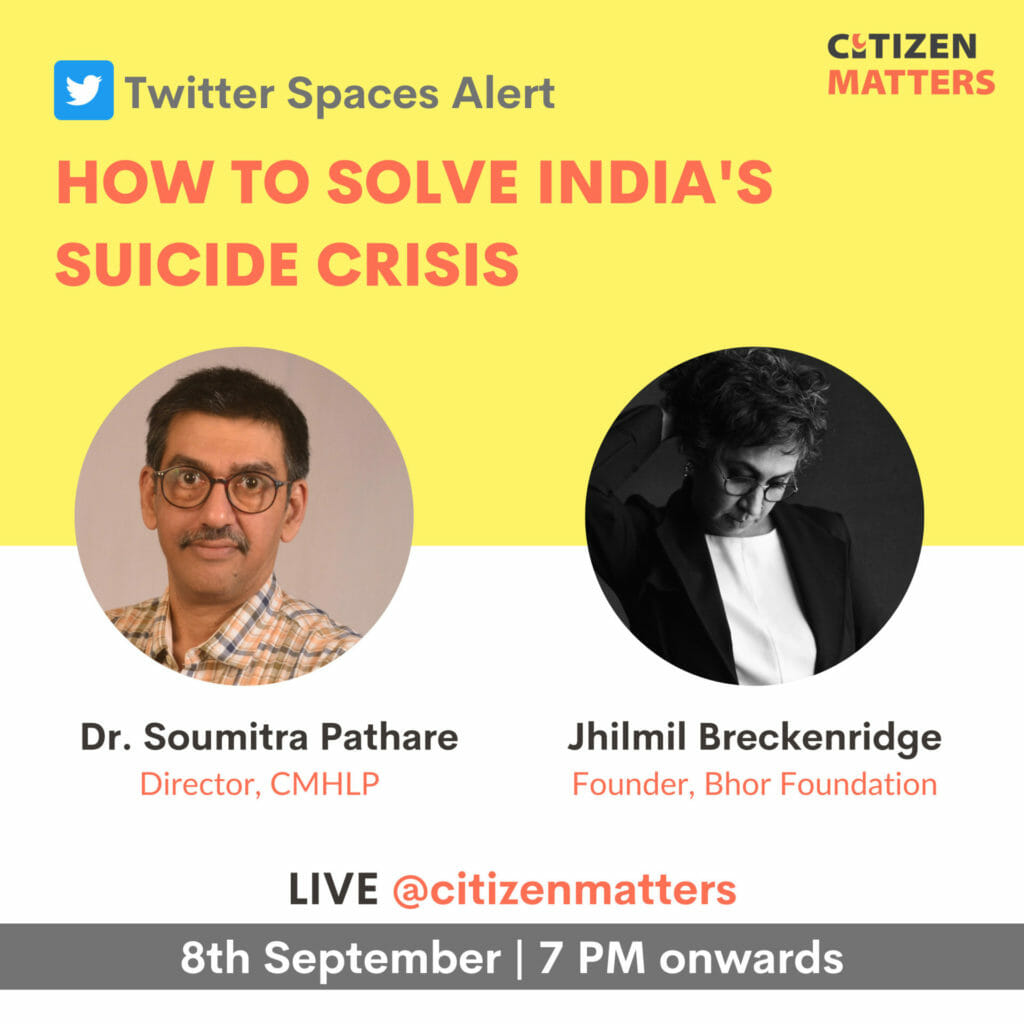Some make headlines and cause nationwide furore (especially when a celebrity is involved). Some make it to the news, but as just another statistic without attracting public attention in any measure. While many, many more go unreported, often deliberately brushed under the carpet. All of these, silently or otherwise, add to India’s alarming record of the number of deaths by suicide. The reported numbers for this was 1.64 lakh in the year 2021 alone, though experts say that the real numbers are much higher. But despite the evident crisis that the country faces, suicide prevention rarely receives the systemic focus it calls for.
About a fortnight before the observance of World Suicide Prevention Day on September 10th, the Indian National Crime Records Bureau released its report for the year 2021, highlighting yet again the dimensions of the crisis. And on September 8th, Citizen Matters got together with Twitterati, hosting two eminent experts in the field of mental health — Dr Soumitra Pathare and Jhilmil Breckenridge — on the Twitter Spaces platform, to discuss how suicide prevention could become real and feasible.
Dr Soumitra is a consultant psychiatrist and the director of the Centre for Mental Health Law and Policy (CMHLP) in Pune. He has provided technical assistance to the Ministry of Health and Family Welfare in drafting India’s new mental health care act 2017, which takes a rights-based approach to the issue.
Jhilmil, poet, activist and writer is the Founder of Bhor Foundation, an Indian charity, which is active in mental health advocacy. She advocates poetry and arts as therapy and is working on a few initiatives, both in the UK and India, taking this into prisons and hospitals.
Both speakers stressed on the multiple dimensions of suicide as an issue and the holistic approach to be adopted — both at a national and community level.
Needed: Both a structural and a community approach
Suicide cases in our country have been almost invariably viewed as individual cases, with a focus on the particular or peculiar circumstances of the case. Rarely ever as an overall public health issue.
As Dr Soumitra said during the conversation, the entire health system in the country has mostly focused on the individual, harping on individual circumstances or treatment for medical problems. Health issues, mental or otherwise, are rarely seen as a structural problem calling for systemic changes.
Jhilmil, who has worked extensively with sufferers of mental illness and their families, also sees ‘medicalisation’ as a direct consequence of the stigma and myths around such conditions and the resulting denial of the family. There is rarely ever, in her words, “a trauma-informed lens (that) will look at the family, will look at society, and will look at the fabric of what created the distress.”
And in all of this, what is most lacking is what Dr Soumitra referred to as the belief that suicides can be prevented. In the absence of this conviction, efforts towards suicide prevention remain half-hearted attempts at best.
“In my experience of talking to policymakers, community leaders, even the general average person, there is a certain kind of negativity around it…my impression has always been that they don’t really, in their heart of hearts, believe that whatever they do could actually reduce suicides,” he said during the discussion. The result is a kind of fatalistic resignation to the rising numbers and a lack of targeted action.
So what is the way forward in evolving a suicide prevention policy and getting rid of the very dubious distinction of being the nation with the most number of reported cases?
The one-hour long discussion, which you can hear in full at the link below, brought out several critical facets of suicide as a phenomenon, and how it is usually looked at or dealt with. Understanding and interpreting the trains of thought that emerged from Dr Soumitra, Jhilmil, and even some of the listeners, could yield definite prescriptions and suggestions for all stakeholders — from policy makers to community members, including us.
A few key pointers from the discussion
Some of the most pressing imperatives that emerged from the discussion were as follows:
Devise an intersectoral strategy to address the problem of suicides
Deaths by suicide are usually the result of layered issues, not all of which are clinical. In an earlier conversation with Citizen Matters, Dr S Kalyanasundaram, a Bengaluru-based senior consultant psychiatrist had pointed to the phenomenon of farmer suicides as an example, which is far from being a clinical issue but is inextricably linked with social, economic and other pressures.
The same point came out when Dr Soumitra said that the health sector certainly cannot and should not be the only player to be involved where suicide prevention is concerned. He gave the example of suicides among children/students, which would be impossible to reduce without the involvement of the education sector. Similarly, to bring down suicides among women it would be absolutely essential to ensure the active participation of the social justice department or the women and children’s department.
The structural issues leading to suicides are intersectoral and therefore we need an intersectoral policy, where all concerned work in tandem with the health sector to bring down the numbers.
Read more: What is behind the alarming rise in suicides in Srinagar?
We need more books, films and popular culture to inform and make us more empathetic
Jhilmil pointed to the present nature of media which leads to an ‘othering’ of mental health issues. In the way that media reports on suicide, and the way certain cases are sensationalised, it fosters the feeling that this is not something that can happen to us. It is always someone else’s problem, a problem belonging to another social milieu.
To add to the problem, historically the suicidal person has been portrayed as someone who is ‘not normal’ or ‘crazy’. They have been viewed through a judgmental lens with various labels attached to them. But if we had more empathetic films, more sensitive and real portrayals of mental health issues, how it could affect just about anybody and how it could be prevented, the lens could change.
To quote Jhilmil verbatim, “I think in order for families to change and communities to change and societies to become more accepting, and more compassionate and more empathetic, possibly we need more writing, more films, more music, much more of these. That’s why I do so much with the arts, because I think it’s a way to start changing people’s minds.”

Representational image. Pic: Congerdesign/Pixabay
More is possible with less — but it’s gotta be done
India’s public healthcare spending has been notoriously low, and predictably therefore, the allocations towards mental health even more so. But Dr Soumitra was of the opinion that where suicide prevention is concerned, a lot more could be done with whatever we have. And he said that Jhilmil’s point about the role of media was a good example.
“There is good evidence from across the world, that getting the media to report suicides more responsibly will reduce suicides by at least 1 to 2%. There’s lots of evidence for this. There’s research on it,” the doctor said. And while 2% may sound like a measly figure to quote, in the Indian context with 1.64 lakh reported suicides, that’s well over 3000 lives saved. Not to mention the unreported cases, even a conservative estimate for which would push up the absolute numbers even more.
“And that’s not costing us anything… it does not require any new resources or new finances,” he added, citing the example of a free online training programme for journalists that the CMHLP offers. “It’s only two or three hours, you can go online, do it at your own convenience. Why won’t media houses insist that their journalists actually do this kind of course, so that they can report on suicides more responsibly?”
Dr Soumitra also referred to the example of Tamil Nadu where activists campaigned hard and got the state government to introduce supplementary exams after the board exam results. It was observed that while the number of students writing the examinations doubled over a period of 10 years, the number of post-failure suicides became half of what it used to be. This, as a result of an intervention that could hardly be described as dramatically expensive.
The point, therefore, is that resources are not necessarily a huge stumbling block when it comes to suicide prevention.
Focus on community, focus on the basics
Jhilmil made a strong case for community involvement, as communities can really uplift people. “I think in the urban cities…you don’t even wish your neighbours a good morning, let alone go and have a cup of tea or share some snack together… But I think each individual can help another and I think by helping another person, you also feel happier from inside, knowing that I took something to my neighbour or I did something for XYZ without expecting anything in return.”
She also stressed on the simplicity and basics of life as it once was — a life that involved working with your hands, being close to nature, eating seasonal local food, taking the time to have a nap every day. She also referred to the Goan concept of ‘susegad’ which is known to foster a sense of contentment, arising from involvement in community and a relaxed way of life.
Read more: Mental Health: Why you and I have a critical role to play
Think data, press for evidence-based action
Data often belies many of the things that are intuitively thought to be effective, and hence Dr Soumitra firmly emphasised the need for evidence-based policy. Support for communities could be wedded to structural issues, as evidenced in the example of Brazil, which introduced a conditional cash transfer in 2004.
The amount of the transfer was not spectacular, but conditions attached were such as would boost the overall welfare of the community. “For example, if you were a pregnant woman receiving the transfer, you would have to go for your antenatal visits, or even otherwise, you would have to ensure your children were going to school. And these were at public healthcare facilities, or in public schools, so they did not really require them to spend any additional money,” explained the doctor.
15 years later, Brazil had data on a 100-million strong recipient population, which showed that suicides among the people who got the conditional cash transfers were a whopping 61% lower than those who did not get the cash transfer. The impact was reportedly more prominent among younger people. This was the kind of support to community that Soumitra said could make a real difference. In the Indian context, an effective suicide policy prevention would have to factor in ways to curb issues such as alcoholism and domestic violence, he said.
These and several other crucial but not-often-discussed points came out during the hour-long discussion, including some very pertinent observations and questions from Twitterati listening in. And if you are wondering, what your role as a citizen could be in suicide prevention, what you could do, please listen to the complete recording of the discussion shared above.
Also read:
- Interview: How can Chennai bring its steeply rising suicide curve down?
- Kolkata: These communities have no access to mental health care even when they need it
- Mental illness a ticking time bomb, say experts
If you, or anyone you know, is experiencing any form of mental distress, please reach out to a trusted source for help. Some of the helplines you can call:
- Roshni Helpline: +91 4066202000
- Sneha Foundation India: +91 4424640050
- Sumaitri Helpline: 011-23389090
- The Samaritans Mumbai: 8422984528/29/30
- Connecting India: +91 9922001122
- Cooj: +91 8322252525
- Vandrevala Foundation: +91 1860-2662-345, 1800-2333-330
- Parivarthan: 080-6533-3323
- Saath: 079-2630-5544, 079-2630-0222
- iCall: 022-2552-1111
- Lifeline Foundation: 033-2463-7401, 033-2463-7432
- Aasra Suicide Prevention Hotline: (022)27546669.
